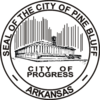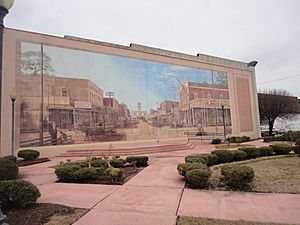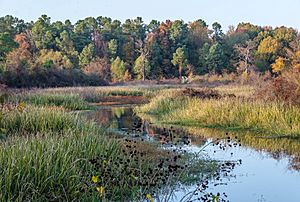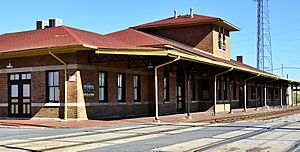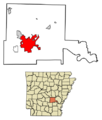Pine Bluff, Arkansas facts for kids
Quick facts for kids
Pine Bluff, Arkansas
|
||
|---|---|---|
| City of Pine Bluff | ||
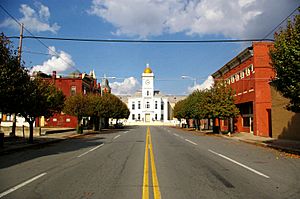
Downtown Pine Bluff
|
||
|
||
| Motto(s):
"City of Progress"
|
||
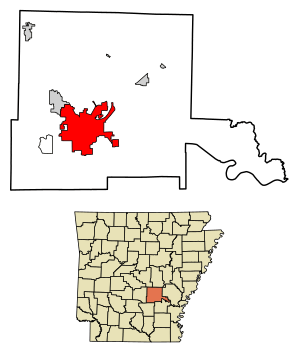
Location in Jefferson County and Arkansas
|
||
| Country | ||
| State | ||
| County | Jefferson | |
| Township | Vaugine | |
| Incorporated | January 8, 1839 | |
| Government | ||
| • Type | Mayor–Council | |
| Area | ||
| • City | 46.38 sq mi (120.12 km2) | |
| • Land | 44.18 sq mi (114.43 km2) | |
| • Water | 2.20 sq mi (5.69 km2) | |
| Elevation | 226 ft (69 m) | |
| Population
(2020)
|
||
| • City | 41,253 | |
| • Density | 933.71/sq mi (360.50/km2) | |
| • Metro | 100,258 | |
| Time zone | UTC−06:00 (CST) | |
| • Summer (DST) | UTC−05:00 (CDT) | |
| ZIP code(s) |
71601, 71602, 71603
|
|
| Area code(s) | 870 | |
| FIPS code | 05-55310 | |
| GNIS feature ID | 2404520 | |
| Major airport | Clinton National (LIT) | |
Pine Bluff is a city in the state of Arkansas, USA. It's the tenth-largest city in Arkansas and the main city of Jefferson County. In 2020, about 41,253 people lived here.
The city is in the southeastern part of Arkansas, near the Arkansas Delta and the Arkansas Timberlands. The land is mostly flat with lots of farms. Pine Bluff has many streams and bayous, including Bayou Bartholomew, which is the longest bayou in the world! You can also find Lake Pine Bluff, Lake Langhofer, and the Arkansas River here.
Contents
History of Pine Bluff
Pine Bluff has many places listed on the National Register of Historic Places. These are important sites that tell us about the city's past.
Early Days of Pine Bluff
For thousands of years, different groups of indigenous peoples lived along the Arkansas River. They used the river for travel and fishing. When Europeans arrived, the Quapaw people were living in this area.
The city of Pine Bluff was started by Europeans on a high bank of the Arkansas River. This area had many tall pine trees. The high ground was a safe place from floods for the early settlers.
In 1819, a fur trader named Joseph Bonne, who was part Quapaw and part French, settled here. Later, in 1824, the Quapaw people signed a treaty with the United States. This meant they gave up their land claims in Arkansas.
More American settlers then joined Bonne. In 1829, Thomas Phillips claimed the land where Pine Bluff is now. Jefferson County was officially created on November 2, 1829.
On August 13, 1832, the pine bluff area was chosen as the county seat. The village was named "Pine Bluff Town" on October 16, 1832. Pine Bluff became an official city on January 8, 1839. At that time, only about 50 people lived there. Better transportation, like steamships, helped Pine Bluff grow in the 1840s and 1850s.
From 1832 to 1838, Pine Bluff residents saw Native American groups on the Trail of Tears. These groups were forced to move from the American Southeast to Indian Territory. From 1832 to 1858, Pine Bluff was also a stop for Black Seminoles who were forced to move from Florida.
Civil War and Growth (1861-1900)
Before the American Civil War, Pine Bluff was a rich city. Its wealth came from cotton, grown on large farms by many enslaved African people. By 1860, Pine Bluff had one of the largest enslaved populations in Arkansas. Jefferson County was the second-biggest cotton producer in the state.
When Union soldiers took over Little Rock, people in Pine Bluff asked them for protection. Union troops arrived on September 17, 1863, and stayed until the war ended.
Confederate General J.S. Marmaduke tried to push the Union Army out during the Battle of Pine Bluff on October 25, 1863. But the Union soldiers and freedmen (formerly enslaved people) fought back and won. After the war, formerly enslaved people worked to start schools for Black children and adults. In 1872, the Branch Normal School of the Arkansas Industrial University opened. Today, it's the University of Arkansas at Pine Bluff, Arkansas's first public college for Black students.
Building railroads helped the economy recover after the war. The first railroad reached Pine Bluff in December 1873. The city also got its first gas company for lighting in 1873.
In the 1870s, as people became wealthier, they built large Victorian-style homes. During this time, African Americans gained more rights. Many joined the Republican Party, and some were elected to local and state offices. Black-owned businesses, like banks and barbershops, also opened.
However, things became harder for African Americans later in the 1800s. Laws like the poll tax made it difficult for many Black and poor white people to vote. Jim Crow laws were also put in place, which created legal segregation.
Despite these challenges, Pine Bluff grew. By 1890, it was the third-largest city in Arkansas. The first telephone system started in 1883. Wiley Jones, a formerly enslaved man who became wealthy, built the first mule-drawn streetcar line in 1886. The first light, power, and water plant was finished in 1887. The growing lumber industry also helped the economy.
Early 1900s and the Great Depression (1900-1941)
Pine Bluff relied on river trade. To keep the Arkansas River flowing near the city, the United States Army Corps of Engineers built a levee. However, during a later flood, the river's main path moved away, leaving a small lake. This lake was later expanded into Lake Pine Bluff.
River traffic decreased, and the river became a barrier within the county. After many years, the Free Bridge opened in 1914, connecting the county permanently.
African Americans in Pine Bluff continued to fight for their rights. They joined boycotts against segregated streetcars in 1903, but the laws didn't change then.
The city's business area grew quickly. The Masonic Lodge, built by and for the African-American chapter, was the tallest building in Pine Bluff in 1904. The Hotel Pines, built in 1912, was a beautiful hotel. The Saenger Theater, built in 1924, was one of the largest in the state. When Dollarway Road was finished in 1914, it was the longest concrete road in the U.S. Arkansas's first radio station (WOK) broadcast from Pine Bluff in 1922.
Two natural disasters hurt the economy. The Great Mississippi Flood of 1927 flooded much of Jefferson County. Then, a severe drought in 1930 caused crop failures, making the Great Depression even worse for Pine Bluff. Many banks failed in 1930.
New highways built in the late 1920s and early 1930s helped trade. President Franklin D. Roosevelt's programs, like the Works Progress Administration (WPA), helped Pine Bluff build new schools, a football stadium, and Oakland Park. A stockyard was built in 1936 to help farmers sell their livestock.
From 1936 to 1938, the WPA collected stories from formerly enslaved people. Pine Bluff residents contributed many of these important oral histories. Country singer Johnny Cash also came to Pine Bluff during the 1933 Mississippi River flood.
World War II and Modern Era (1941-Present)
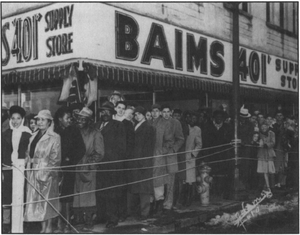
World War II brought big changes. The Army built Grider Field Airport, which trained pilots for the U.S. Army Air Corps. About 9,000 pilots were trained there before it closed in 1944.
The Pine Bluff Arsenal was built in 1941. The arsenal and Grider Field helped Pine Bluff's economy become more diverse, mixing industry with agriculture. Defense spending during the Korean War also helped keep the economy stable.
In 1953, KATV television station, then in Pine Bluff, made Arkansas's first VHF broadcast. In 1957, a new paper mill was announced, and International Paper Co. bought land nearby. In 1958, Dr. Martin Luther King, Jr. spoke at Arkansas AM&N College (now the University of Arkansas at Pine Bluff).
The 1960s brought the civil rights movement. African Americans protested to end segregation. There were boycotts and demonstrations. Some people reacted with violence, but local leaders worked for change. Voter registration drives, student protests, and a desire to avoid bad media attention led to reforms.
In the 1960s and 1970s, many large projects were built. These included Jefferson Hospital, dams on the Arkansas River, a Federal building, the Pine Bluff Convention Center, and new parks. Jefferson Square became the first major shopping center.
The 1980s and 1990s saw more construction. Benny Scallion Park was created, featuring a Japanese garden (though it's not maintained today). The Pines, a large enclosed shopping center, was built in the late 1980s.
In the 1990s, a southern bypass (part of Interstate 530) was completed. A new highway and bridge also connected farm areas to Pine Bluff. The Arts and Science Center for Southeast Arkansas was built downtown in 1994. Pine Bluff Downtown Development started a historical mural project, which brings in more tourism.
In 2000, the Donald W. Reynolds Community Services Center was finished. Carl Redus became the first African American mayor in 2005. The University of Arkansas at Pine Bluff opened a business incubator downtown. A new farmers market pavilion also opened on Lake Pine Bluff.
On November 6, 2012, Debe Hollingsworth was elected mayor. She planned to focus on fighting crime, creating jobs, improving government and education, and making Pine Bluff's image better.
Geography and Climate
Pine Bluff is located on the Arkansas River. The city was named for a bluff (a high bank) along the river. Lake Pine Bluff and Lake Langhofer are within the city. These lakes are parts of the old Arkansas River channel. The Mississippi Alluvial Plain (or Arkansas Delta) extends into the city, with Bayou Bartholomew marking the border between the Delta and the Arkansas Timberlands.
Levees and dams protect the area from floods and changes in the river's path. One of the world's longest individual levees, about 380 miles long, runs from Pine Bluff to Venice, Louisiana.
Pine Bluff's Climate
The city has a total area of about 46.8 square miles (120.12 km2). Most of this is land, with some water.
| Climate data for Pine Bluff | |||||||||||||
|---|---|---|---|---|---|---|---|---|---|---|---|---|---|
| Month | Jan | Feb | Mar | Apr | May | Jun | Jul | Aug | Sep | Oct | Nov | Dec | Year |
| Mean daily maximum °F (°C) | 51 (11) |
56 (13) |
65 (18) |
75 (24) |
82 (28) |
89 (32) |
92 (33) |
91 (33) |
85 (29) |
76 (24) |
64 (18) |
54 (12) |
73 (23) |
| Mean daily minimum °F (°C) | 30 (−1) |
33 (1) |
42 (6) |
51 (11) |
60 (16) |
68 (20) |
71 (22) |
70 (21) |
63 (17) |
51 (11) |
42 (6) |
33 (1) |
51 (11) |
| Average precipitation inches (mm) | 3.8 (97) |
4.4 (110) |
5.1 (130) |
5.0 (130) |
5.3 (130) |
4.2 (110) |
4.0 (100) |
3.7 (94) |
3.8 (97) |
4.1 (100) |
4.6 (120) |
5.5 (140) |
52.4 (1,330) |
People and Population
| Historical population | |||
|---|---|---|---|
| Census | Pop. | %± | |
| 1850 | 460 | — | |
| 1860 | 1,396 | 203.5% | |
| 1870 | 2,081 | 49.1% | |
| 1880 | 3,203 | 53.9% | |
| 1890 | 9,952 | 210.7% | |
| 1900 | 11,496 | 15.5% | |
| 1910 | 15,100 | 31.4% | |
| 1920 | 19,300 | 27.8% | |
| 1930 | 20,800 | 7.8% | |
| 1940 | 21,300 | 2.4% | |
| 1950 | 37,200 | 74.6% | |
| 1960 | 44,000 | 18.3% | |
| 1970 | 57,400 | 30.5% | |
| 1980 | 56,600 | −1.4% | |
| 1990 | 57,100 | 0.9% | |
| 2000 | 55,085 | −3.5% | |
| 2010 | 49,083 | −10.9% | |
| 2020 | 41,253 | −16.0% | |
| 2023 (est.) | 39,123 | −20.3% | |
| sources: | |||
In 2020, Pine Bluff had 41,253 people living in 16,966 households. Most residents (about 77%) were Black or African American, and about 18% were White.
In 2010, the city had 49,083 people. The population density was about 1,048 people per square mile. About 25.5% of the people were under 18 years old. The average age was 33.4 years. The median income for a household was $30,415. About 30.6% of the population lived below the poverty line.
Economy and Jobs
Jefferson County, where Pine Bluff is located, is a rich farming area. Important farm products include cotton, soybeans, cattle, rice, poultry, timber, and catfish.
Major employers in the area are Jefferson Regional Medical Center, Simmons First National Corp., Tyson Foods, Evergreen Packaging, the Pine Bluff Arsenal, and the Union Pacific Railroad. The many paper mills in the area sometimes give Pine Bluff a unique smell.
In 2009, Forbes magazine listed Pine Bluff as one of America's 10 most impoverished cities.
The Saracen Casino Resort opened in Pine Bluff in 2020. It cost $350 million to build and employs over 1,100 people.
Arts and Culture
The Pine Bluff Convention Center is one of Arkansas's largest meeting places. The Arts and Science Center offers theater shows and workshops for kids and adults. Pine Bluff also has downtown murals that show the city's history. You can visit the Pine Bluff/Jefferson County Historical Museum, the Arkansas Entertainers Hall of Fame, and the Arkansas Railroad Museum.
The King Cotton Classic was a famous high school basketball tournament held in Pine Bluff from 1982 to 1999. Many future NBA players, like Corliss Williamson and Jason Kidd, played in it. The tournament returned in 2018.
Education
The University of Arkansas at Pine Bluff (UAPB) is the second oldest public school in Arkansas. It's also the oldest with a Black heritage. UAPB has special programs, like one of the few aquaculture (fish farming) research programs in the country. It also has a museum that shares the history of UAPB and the Arkansas Delta.
The Southeast Arkansas College offers technical career programs and a two-year college degree.
Pine Bluff is served by three school districts: Pine Bluff School District, Watson Chapel School District, and White Hall School District. There are also charter schools and the Ridgeway Christian School.
The Main Library of the Pine Bluff and Jefferson County Library System has a large collection of family history records. This includes an online index of obituaries from the Pine Bluff Commercial newspaper. The library system also has branches in the Watson Chapel area, White Hall, Redfield, and Altheimer.
Colleges and Universities
- University of Arkansas at Pine Bluff
- Southeast Arkansas College
Public Schools
- Pine Bluff School District, including Pine Bluff High School
- Watson Chapel School District, including Watson Chapel High School
- White Hall School District (parts of Pine Bluff are in this district; White Hall High School is in White Hall)
Before schools were integrated, Black students attended separate schools like Merrill High School and Townsend Park High School.
In 2020, the Dollarway School District merged with the Pine Bluff School District. This means all schools from both districts now operate together.
Private Schools
Pine Bluff has two private schools: Ridgway Christian School (for K3–12th grades) and Maranatha Baptist Academy (for K3-12th grades).
In the past, there were Catholic schools like St. Joseph Catholic School and St. Peter's Catholic School. St. Peter's was the first school in Arkansas for Black children, founded in 1889.
City Services and Transportation
Highways
 Interstate 530
Interstate 530 US Route 63
US Route 63 US Route 65
US Route 65 US Route 79
US Route 79 U.S. Route 270
U.S. Route 270 U.S. Route 425
U.S. Route 425 Highway 15
Highway 15 Highway 54
Highway 54 Highway 81
Highway 81 Highway 190
Highway 190 Highway 365
Highway 365
Water Transportation
Pine Bluff is on the Arkansas River, which means boats can travel there. The Port of Pine Bluff is important for shipping goods.
Air Travel
For commercial flights, people in Pine Bluff use the Clinton National Airport (LIT) in Little Rock. It's about a 40-minute drive away.
Pine Bluff also has its own airport, Grider Field (PBF). It's used for corporate and private planes, and for charter and air ambulance services.
Buses
Royal Coach Lines offers bus services for travel within the state and for charters.
The city also has its own bus system, Pine Bluff Transit. It runs six routes on weekdays, connecting different parts of the city.
Railroad
The Union Pacific Railroad provides freight train service to and through Pine Bluff.
Correctional Facilities
The Arkansas Department of Correction (ADC) has several facilities in Pine Bluff. This includes the ADC state headquarters and several prison units.
Utilities
Water Supply
Liberty Utilities provides clean drinking water to Pine Bluff and nearby areas. They pump water from wells and treat it at three plants. The water is then sent to over 18,000 customers through pipes.
Wastewater Treatment
The Pine Bluff Wastewater Utility manages the city's sewage system. They collect wastewater from homes and businesses and treat it at the Boyd Point Treatment Facility. This facility cleans the water before releasing it. The utility has won awards for its good performance.
Parks and Recreation
Townsend Park was built on 100 acres of land. This land was meant to be a park for Black people. It was named after William J. Townsend, a high school principal.
Famous People from Pine Bluff
- Blanch Ackers, painter
- Larry D. Alexander, visual artist, writer
- Broncho Billy Anderson, actor
- Kris Bankston, basketball player
- John Barfield, baseball player
- Mark Bradley, football player
- Clifton R. Breckinridge, U.S. Representative
- Big Bill Broonzy, blues musician
- Charles Brown, blues musician
- Jim Ed Brown, country music artist
- The Browns, country music trio
- Bill Carr, Olympic gold medalist
- Joe Barry Carroll, basketball player
- Monte Coleman, NFL player and coach
- Junior Collins, jazz musician
- Joseph Carter Corbin, educator
- Harvey C. Couch, founder of Arkansas Power & Light
- CeDell Davis, blues musician
- Janette Davis, singer
- L. Clifford Davis, civil rights attorney, judge
- Larry Davis, blues musician
- Jay Dickey, lawyer and politician
- Jeff Donaldson, visual artist
- Marty Embry, professional basketball player, chef, author
- Kenneth B. Ferguson, politician
- Stephanie Flowers, politician
- Vivian Flowers, politician
- Debra Ford, surgeon and academic
- Rodney Shelton Foss, possibly first American killed in World War II
- Charles Greene, Olympic gold medalist
- George W. Haley, U.S. ambassador
- Isaac Scott Hathaway, visual artist
- George Edmund Haynes, first executive director of National Urban League
- Chester Himes, novelist
- Beth Holloway, author
- George Howard, Jr., federal judge
- Mike Huckabee, former Governor of Arkansas
- Torii Hunter, Major League Baseball player
- Don Hutson, football Hall of Famer
- Bobby Hutton, founding member of Black Panther Party
- George G.M. James, author
- Joseph Jarman, jazz saxophonist
- Charles Johnson, baseball player
- David Johnson, football player
- Kenneth Johnson, television producer
- Theresa A. Jones, neuroscientist
- E. Fay Jones, architect and designer
- Camille Keaton, actress
- Carl Kidd, football player
- Lafayette Lever, NBA player
- Henry Jackson Lewis, political cartoonist
- Kay Linaker, actress
- Dallas Long, Olympic gold medalist
- Martell Mallett, football player
- Peter McGehee, novelist
- Dwight McKissic, minister
- Carl McVoy, rock 'n' roll musician
- Chris Mercer, civil rights activist
- Constance Merritt, poet
- Martha Mitchell, wife of U.S. Attorney General
- Raye Montague, US Navy engineer
- Mary Mouser, actress
- Bitsy Mullins, jazz trumpeter
- Smokie Norful, gospel singer
- Freeman Harrison Owens, inventor
- Rita Panahi, commentator
- Ben Pearson, bowyer
- Edward J. Perkins, U.S. ambassador
- Elizabeth Rice, actress
- Andree Layton Roaf, justice of Arkansas Supreme Court
- Willie Roaf, NFL Hall of Famer
- John Roane, former Governor of Arkansas
- Bobby Rush, blues musician
- William Seawell, U.S. Air Force general
- Peggy Shannon, actress
- Les Spann, jazz musician
- Jeremy Sprinkle, football player
- Katherine Stinson, aviator
- James L. Stone, Medal of Honor recipient
- Francis Cecil Sumner, psychologist
- Jerry Taylor, businessman, legislator, Mayor of Pine Bluff
- Clark Terry, jazz musician
- John Thach, U.S. Navy Admiral
- Sue Bailey Thurman, author, lecturer, and historian
- Krista White, winner of America's Next Top Model
- Reggie Wilkes, football player
- Henry Wilkins III, state legislator, academic
- Henry Wilkins IV, state legislator, judge
- Josetta Wilkins, state legislator, academic
- J. Mayo Williams, blues/gospel/jazz producer
Sister City
- Bandō, Ibaraki, Japan – Pine Bluff has been a sister city with Bandō since October 9, 1989.
Images for kids
See also
 In Spanish: Pine Bluff para niños
In Spanish: Pine Bluff para niños


